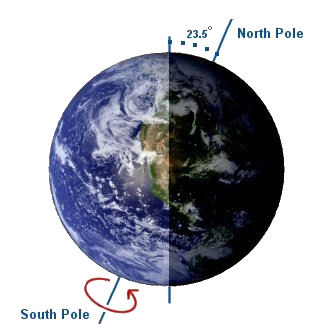The Tilt of the Axis
The seasons on Earth are caused by the
tilt of the Earth's axis relative to its orbit around the Sun.
The seasons are NOT caused by the differences in the DISTANCE from the Sun!
The Earth is actually closer to the Sun in WINTER and farther away in SUMMER.
The axis of the Earth's rotation makes an angle of about 23.5 degrees to a line drawn
perpendicular to the plane of its orbit.

The result is that over the course of a year the peak height of the sun in the sky changes.
When the sun is higher in the sky above a region, the light is
shining down more directly on that region, i.e. more intense. The difference in terms of energy concentration can be dramatic. For example, in Bellingham, WA
the difference in solar energy concentration between the summer and winter solstices is about 30%.
Another factor is the number of daylight hours changing from day to day for any given latitude. For cities in the northern hemisphere
the days are longer in the summer and shorter in the winter. The concentration of sunlight and the length of the daylight hours
are the factors creating warmer or colder months.
At southern latitudes
the roles are reversed, longer days and more direct sunlight in the winter, and shorter less intense sunlit days in
the summer.
Close to the north pole (above the Artic Circle), there are days of the year
when there is
no night at all! As you move just above the Artic Circle, there is at least one
day each summer with no night. The Sun is then always above the horizon and it just
makes a (sinusoidal) 360-degree circuit around you. When you reach the North Pole itself
there are a whole six months when the Sun is just above the horizon (low energy concentration) but never sets. Likewise there are six months of darkness
the rest of the year.
The Solstice and Equinox
For folks living north of the equator, the Sun makes its lowest arc across the sky
on the winter solstice, the shortest day of the year. After that day the
Sun follows a higher and higher path across the sky each day and reaches a point when it is in the
sky for exactly 12 hours (night for the other 12). On the equinox the Sun rises
exactly in the east, travels through the sky for 12 hours, and sets exactly in the west.
Every place on Earth experiences a 12-hour day and 12-hour night.
This happens twice a year - on the vernal (spring) and autumn equinoxes.
After the vernal equinox, the Sun still continues to follow a higher and higher
path through the sky each day, with the days growing longer and longer, until it reaches
it highest point in the sky on the summer solstice in June (longest day of the year).
Here are the current constellations in which we find the Sun positioned at the four cardinal points of the ecliptic.
Vernal Equinox: Pisces
Summer Solstice: Taurus
Autumnal Equinox: Virgo
Winter Solstice: Sagittarius
Heating and Cooling the Earth
If June 21 is the longest day, the day when we receive the most sunshine,
why is it regarded as the beginning of summer and not its peak?
Put another way, why is August hotter than June in the northern hemisphere?
And similarly, why is December 21, the day of least sunshine, the beginning of
winter, and why is February generally colder than December?
Consider the surface of the Earth, especially the oceans, which heat up and cool down
rather slowly. It takes time for the long days to have an effect. In June the oceans are
still somewhat cool from the winter and that delays the peak heat by about a
month and a half. Similarly, in December the water still holds warmth from the
summer, and the coldest days are usually a month and a half or so later, in February.
It takes a few weeks for the changing seasons to have an effect on the average temperature
of a particular region on the planet.